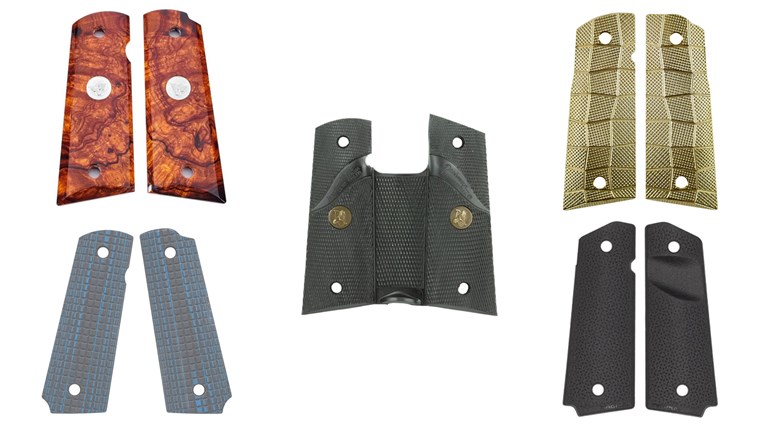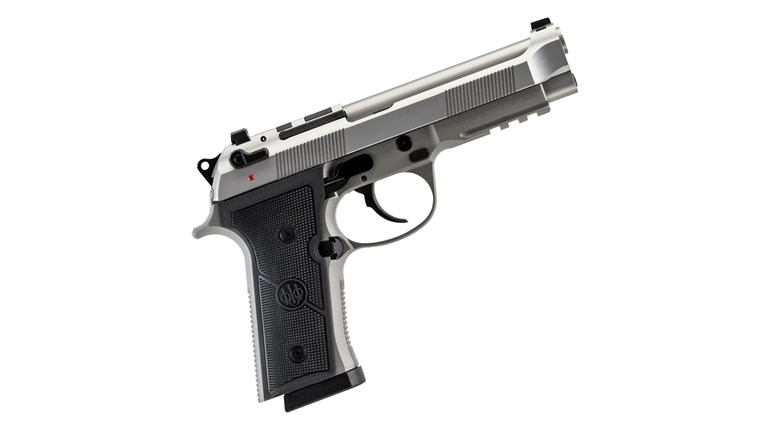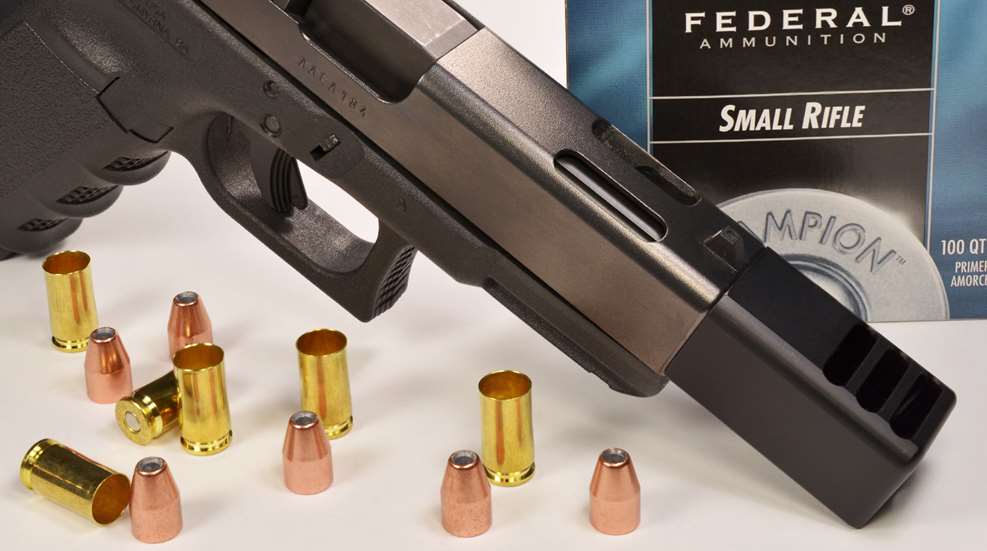
WARNING: All technical data in this publication, especially for handloading, reflect the limited experience of individuals using specific tools, products, equipment and components under specific conditions and circumstances not necessarily reported in the article and over which the National Rifle Association (NRA) has no control. The data has not otherwise been tested or verified by the NRA. The NRA, its agents, officers and employees accept no responsibility for the results obtained by persons using such data and disclaim all liability for any consequential injuries or damages.
Most IPSC and USPSA Open Division semi-automatic pistols have barrels that are five inches or longer, depending on the compensator’s design since most are built around standard full-size 1911 and 2011 pistols. These aren’t the only guns used for Open Division pistols, of course, and their barrel lengths vary depending on the gun model.
Not long ago, 1911 and 2011 barrels (and slides) began to shrink to make the gun shorter. A shorter gun has a lighter muzzle and transitions quicker from one target to another. Both IPSC and USPSA are games of speed. Speed wins matches, and a maneuverable gun can shave fractions of a second from transitions―enough time to matter for many competitors.
As a result, we’re now seeing 1911/2011 “shorties” in Open Division, which are, roughly speaking, anything with less than the standard 5-inch slide. Today’s “shorties” can have barrels as short as four inches.
There has been a trend for many Open Division shooters to switch from the traditional .38 Super to 9mm Luger. This came about when the rules where changed to allow 9x19 caliber guns when the Major power factor was dropped to 165. Brass in 9mm costs less than .38 Super brass, which has been the driving force behind this change. In fact, many 9mm shooters get free brass as pick-ups at the range, or buy once fired 9mm which are much more plentiful than once-fired .38 Super.
Nine millimeter Luger ammunition loaded to Major power factor is called 9 Major―to distinguish it from regular 9mm Luger, 9mm +P and even off the shelf +P+, which might not make the power factor required for competition. A 165 power factor (bullet weight times velocity divided by 1,000) means that 115-grain bullets must go at least 1435 fps.
In a 1911/2011 design gun, which can also handle the longer .38 Super cartridge, a 9 Major round can be loaded longer than the 9mm’s normal maximum overall length of 1.169 inches with some bullets if using .38 Super-length magazines. A longer overall length reduces chamber pressure, and ‘loading long’ is desired for this reason, and might aid feeding reliability as well. But some Open Division guns are built on guns designed around the 9mm Luger cartridge (i.e. Glock, CZ, S&W M&P, etc.), or use spacers in .38 Super magazines which limits them to 9mm length, so loading long is not an option. In these instances, 1.169 inches might be the most you have to work with.
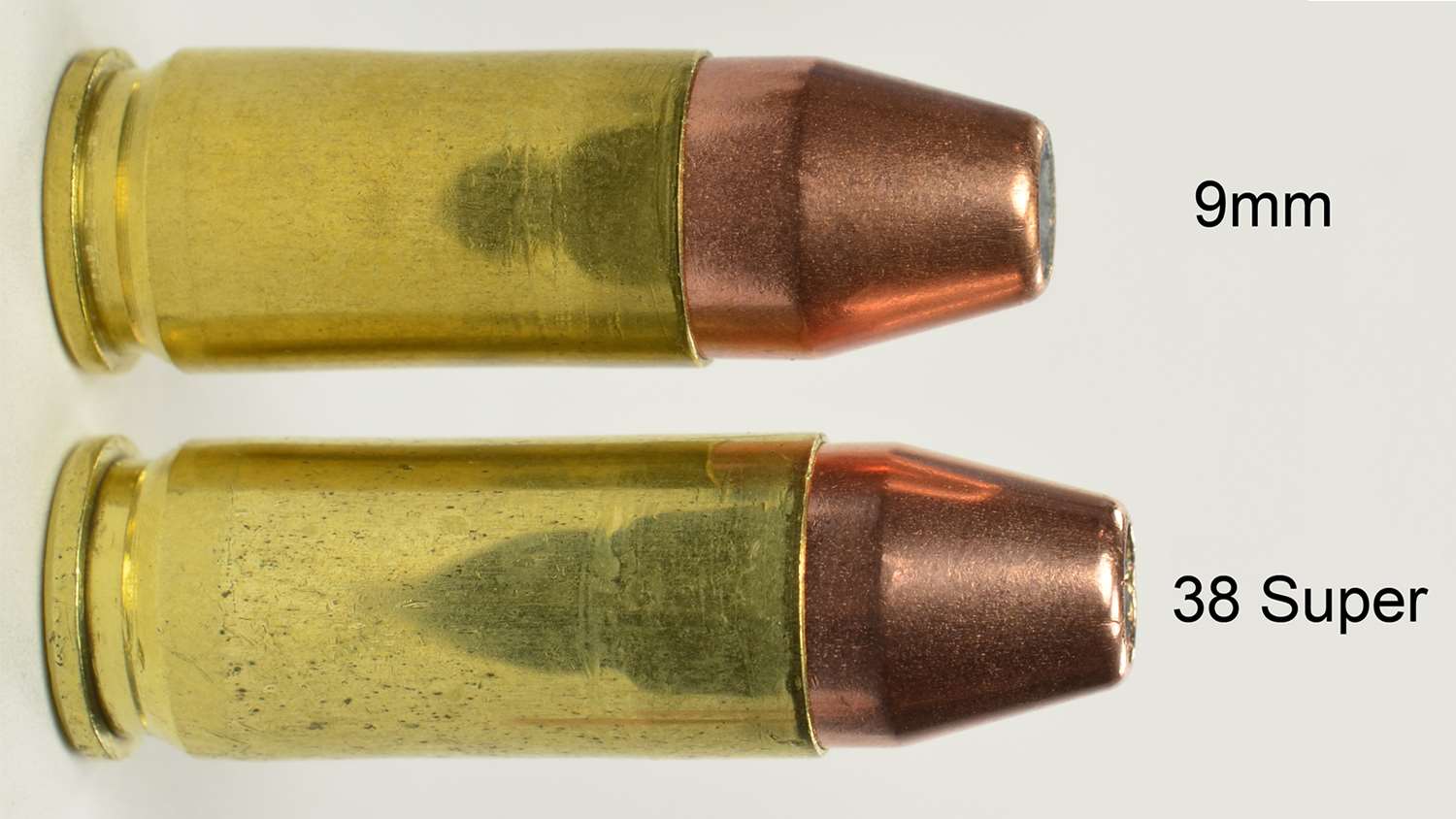
Combining 9 Major loaded to 9mm length and a short barreled gun in Open Division means that the ammunition must be loaded to very high pressure in order to make the minimum power factor. Loading 9 Major to its nominal length limits the number of powders one can use compared to the .38 Super which has more room because it is longer. Less case capacity means higher pressure, which reduces the number of powders that can be utilized to stay within safe pressures.
I loaded various powders for 9 Major in a barrel that fits the “short barrel and 9mm length ammo” category. The base gun was a Glock G19C, which uses a 4-inch barrel. I used a 4.6-inch Alpha Wolf barrel from Lone Wolf. The Alpha Wolf barrel is fluted and coated with a black salt bath nitride coating, which is similar to Tenifer. The barrel is threaded 1/2 x 28 for the compensator of your choice. The chamber offers good case support for 9mm ammunition.
These barrels are made from stress relieved 416 stainless steel and are traditional land-and-groove button rifled. This is so they can shoot all types of bullets, including lead. Additionally, they are heat treated to RC 40-42.
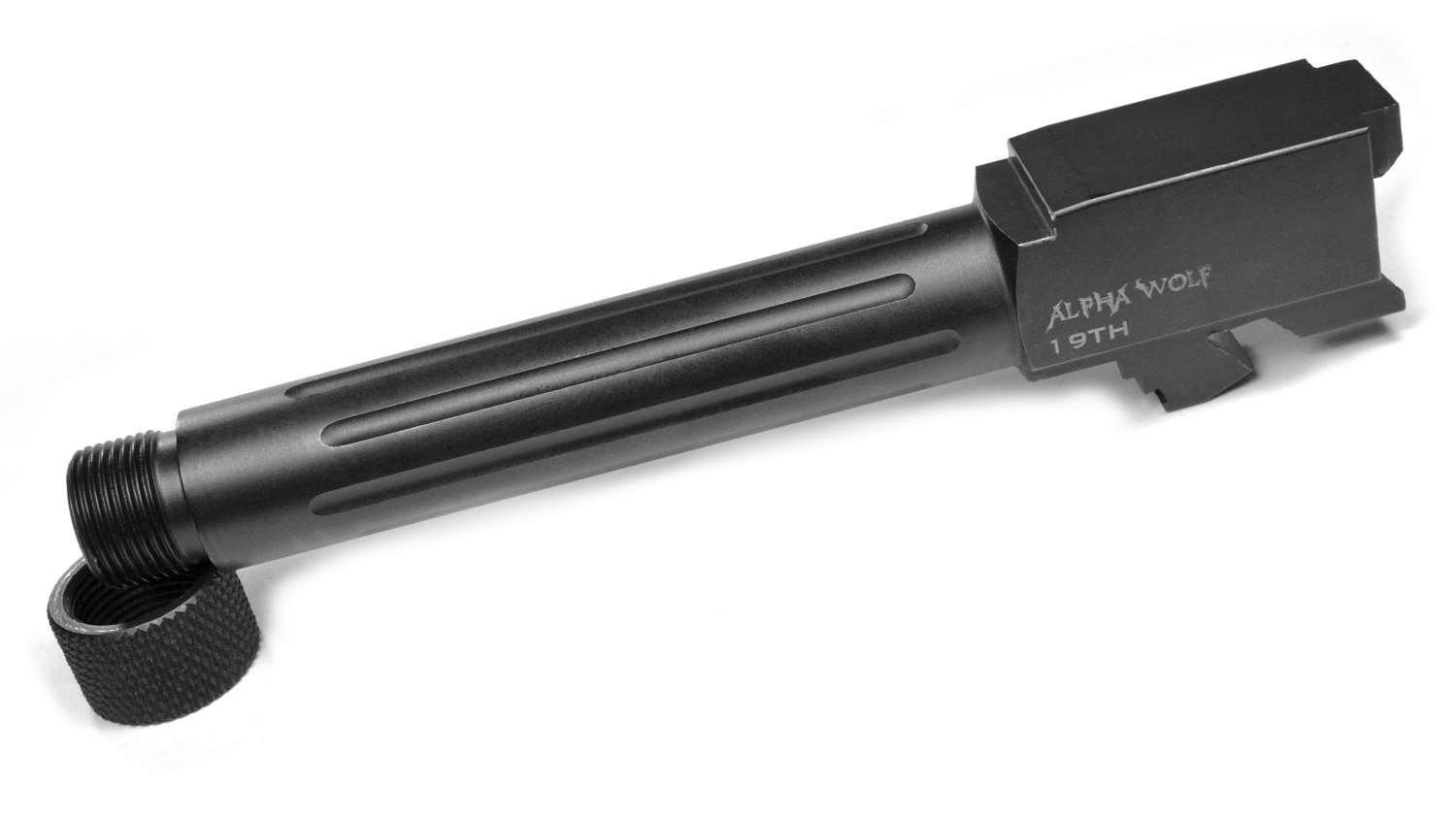
I used two bullets for my loads, 115-grain and 125-grain Hornady Action Pistol (HAP). The Alpha Wolf chamber is cut deep enough that it accepted these bullets loaded to 1.150-inches. This is about the maximum length of a flat nosed bullet that can fit in my Glock, and aftermarket, magazines. Round nose bullets can be loaded out to 1.169-inches, but not any longer for these magazines.
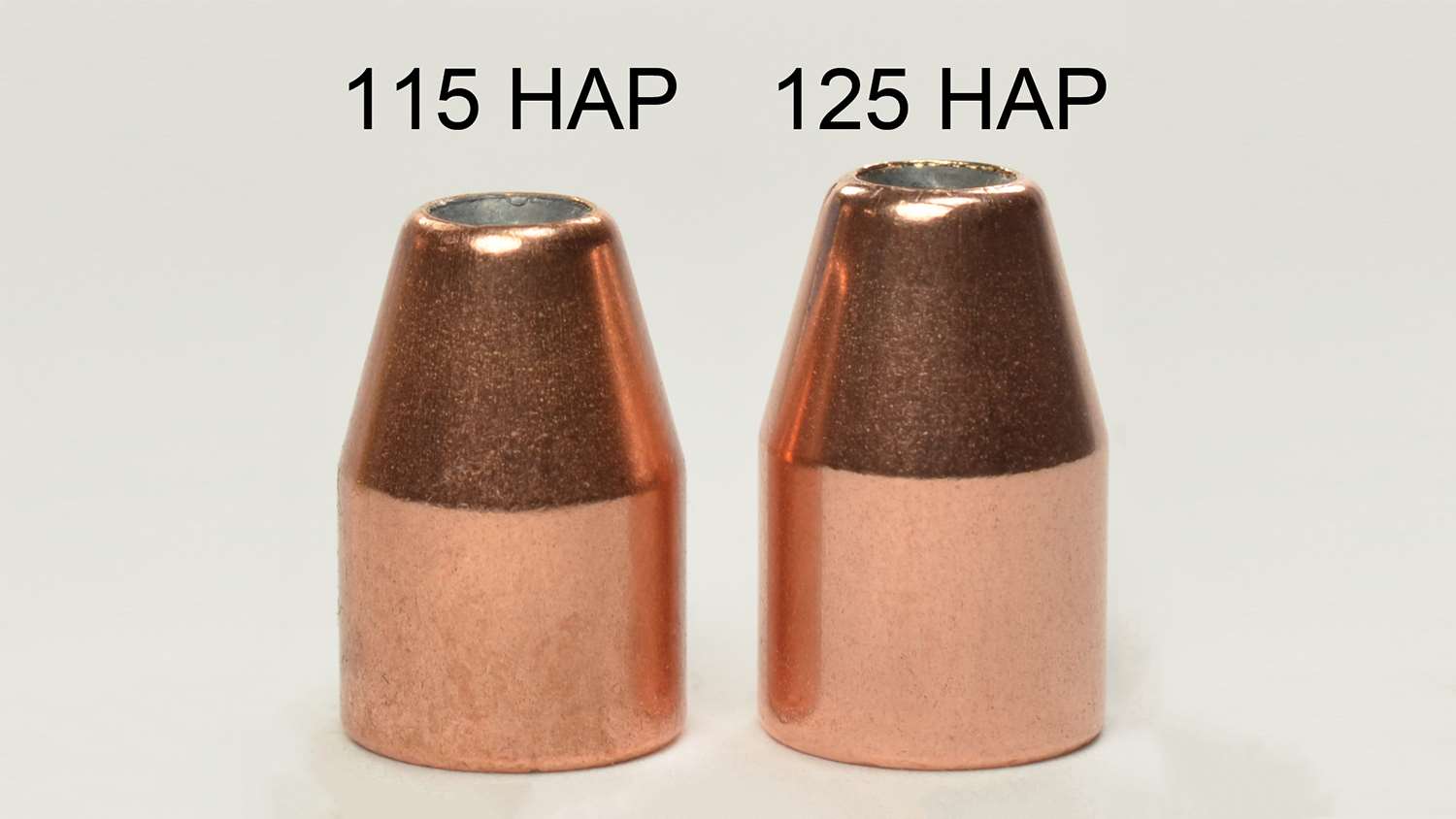
Seven powders were used that are often referred to for use in 9 Major on the Brian Enos forum; AutoComp, HS-6, Silhouette, Accurate #7, 3N37, N350 and 3N38.
Powders differ with respect to how much gas they provide for the compensator. Powders that use larger charge weights provide more gas, and more gas means more gas pressure which translates into more downward force on the barrel/gun as the gas blasts upward from the compensator chamber ports and/or barrel popple holes.
Most of the powders in this article are loaded to pressures that exceed the SAAMI and CIP limits for the 9mm Luger and +P cartridges in order to make Major power factor. For example, the maximum load in Hodgdon’s reloading guide for 9mm Luger and a 115-grain bullet with AutoComp is 5.6 grains. My 9 Major load used 7.5 grains.
Vihtavuori 3N38 can achieve major power factor in many barrels and remain within, or close to, normal operating pressure limits of the 9mm Luger cartridge. See Vihtavuori’s data for the 9X21 in their load manual, which has the same CIP pressure limit as the 9mm Luger. 3N38 fills the case nearly to the brim when using 115-grain bullets, and is a compressed load. The other Vihtavuori powders also tend to fill the case more than the other powders used.
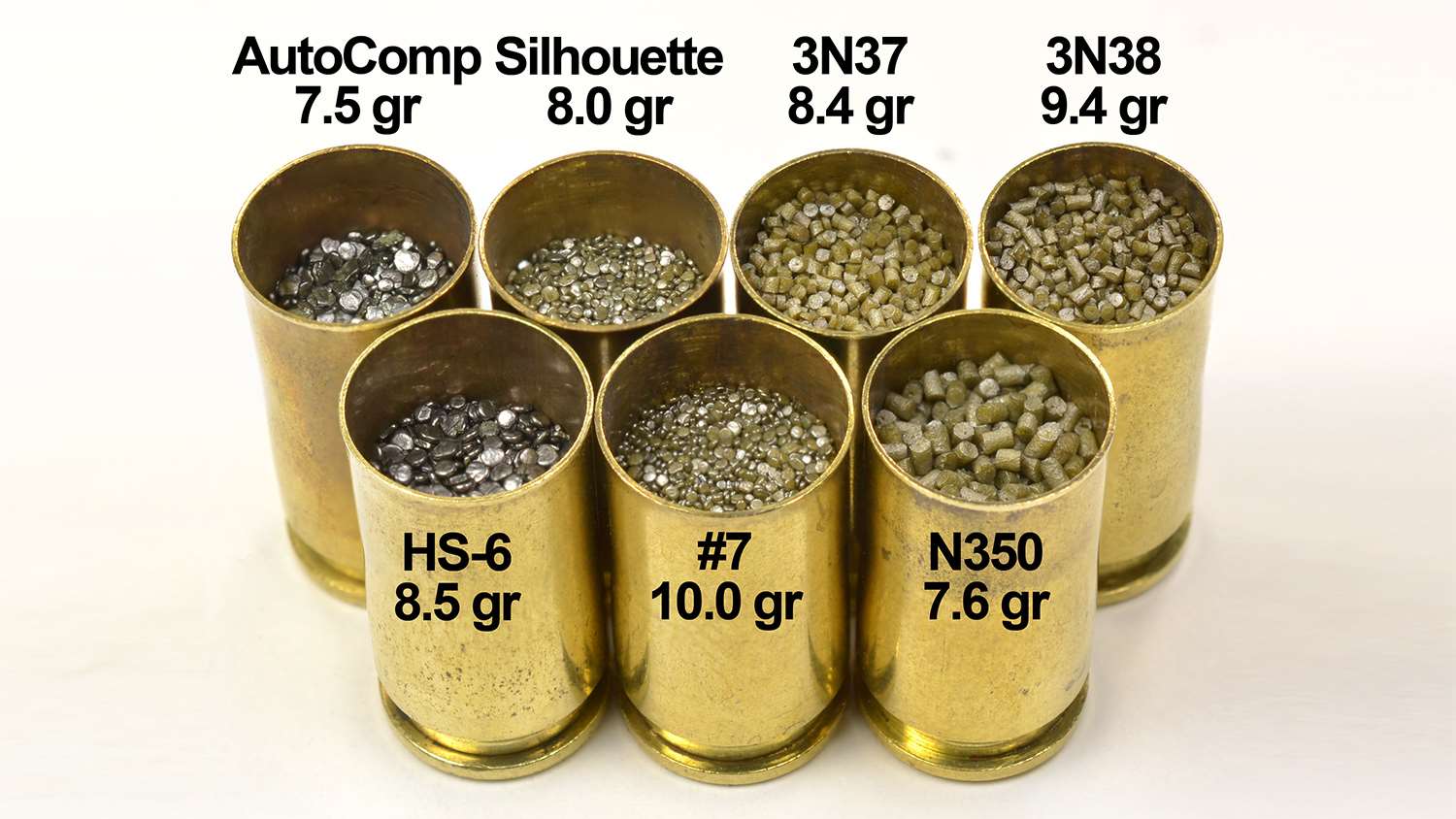
A few shooters have noticed that their loaded rounds will lengthen over time if they are using powders that have been highly compressed. This might depend on the powder, bullet, brass, neck tension, crimp and how long ago they were loaded. It’s something to watch for if you’re compressing your powder. If they grow too much they might not fit in the magazine or chamber, which will depend on your tolerances. I loaded 115-grain HAP bullets with 3N38 and measured them one week later. They had not lengthened.
Powders also differ in how much pressure they produce in order to push the same bullet to the same speed. In general, faster powders will result in higher peak chamber pressure than slower powders. But it should be emphasized that peak chamber pressure does not predict the gas pressure at the compensator. Even though a faster burning powder might produce a higher peak chamber pressure, it might produce a lower gas pressure at the compensator1. The most reliable predictor of gas pressure at the compensator is the charge weight. Powders with larger charge weights result in less muzzle rise in compensated pistols2.
First, I tested several brands of new brass to assess which brands might better suit high pressure rounds: Blazer, Federal, Fiocchi, Lapua, Sellier & Bellow, Starline and Winchester. I fired them in a 5-inch Rock Island Arsenal (RIA) barrel which had a little less case support than the Alpha Wolf barrel. I measured case bulge at the head where the case is not supported. The load was a 115-grain Winchester JHP bullet seated to 1.145 inches over 7.8 grains of AutoComp. This load produced a speed of around 1535 fps (176 power factor) in my RIA barrel.
The Blazer brass expanded the least. Sellier & Bellot came in second. Federal, Fiocchi, Lapua and Winchester brass had about the same expansion. Starline brass expanded the most. Note, my results apply only to the samples I had on hand, and might be different with different lot numbers of cases from the same manufacturer.
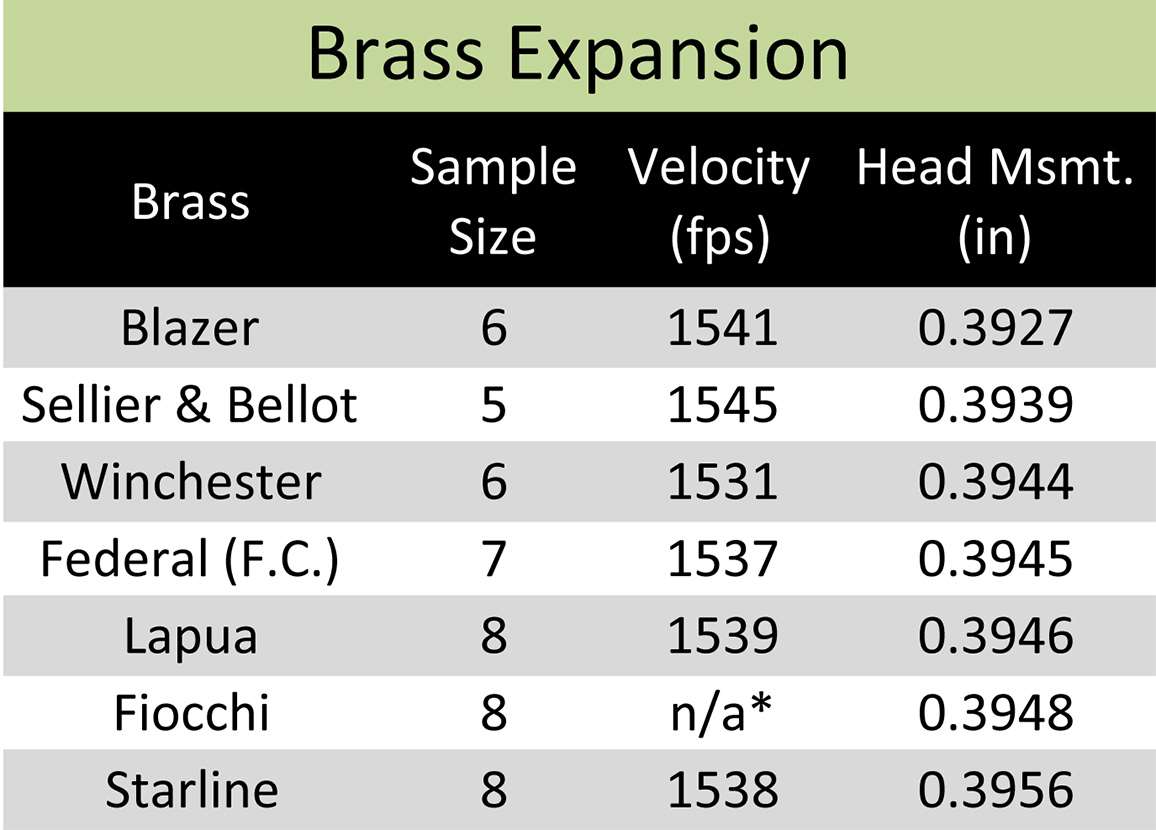
Based on my results, I used Blazer brass for these 9 Major loads. I observed no evidence of excessive bulging in the unsupported region of the Alpha Wolf barrel. Federal small rifle primers were used to reduce primer flow from the high pressure. Some folks have successfully used pistol primers for 9 Major, but you’ll have to watch for primer flow in your gun.
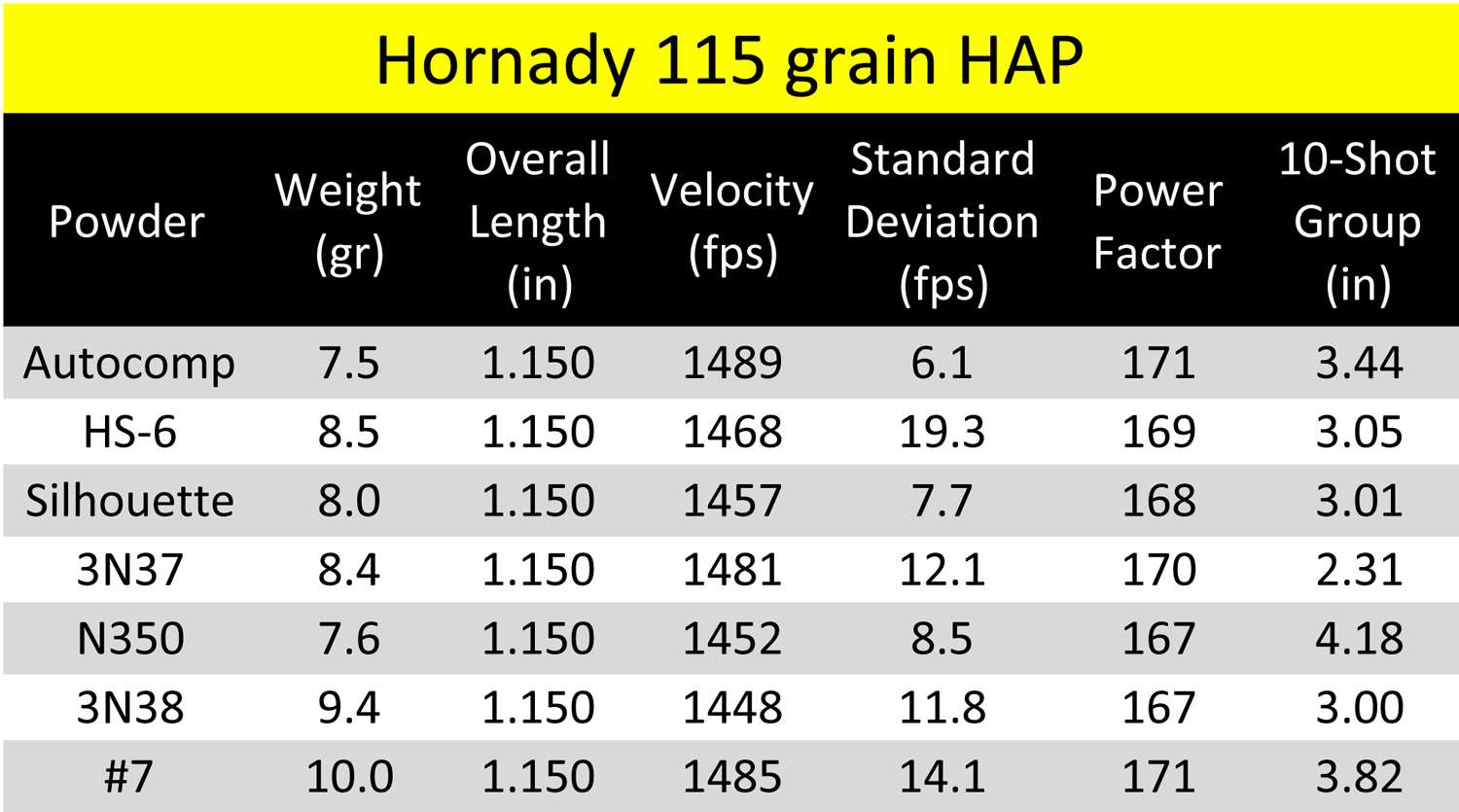
The gun was fired from a Ransom Rest, and accuracy was assessed at 25 yards with a 10-shot group. Velocity was recorded with a Shooting Chrony chronograph at about 10 feet, and is the average of 10 shots.
All the loads shown exceeded a 165 power factor. The data shown here is presented as a guide and not as definitive loads for your barrel. You have to develop your loads in your gun with a chronograph. Start below the charge weights shown here and work up with your chronograph and watch for pressure signs. Differences in powder lot numbers and barrels can produce significant differences in pressure and velocity. If you see high pressure signs, try a different (slower) powder.
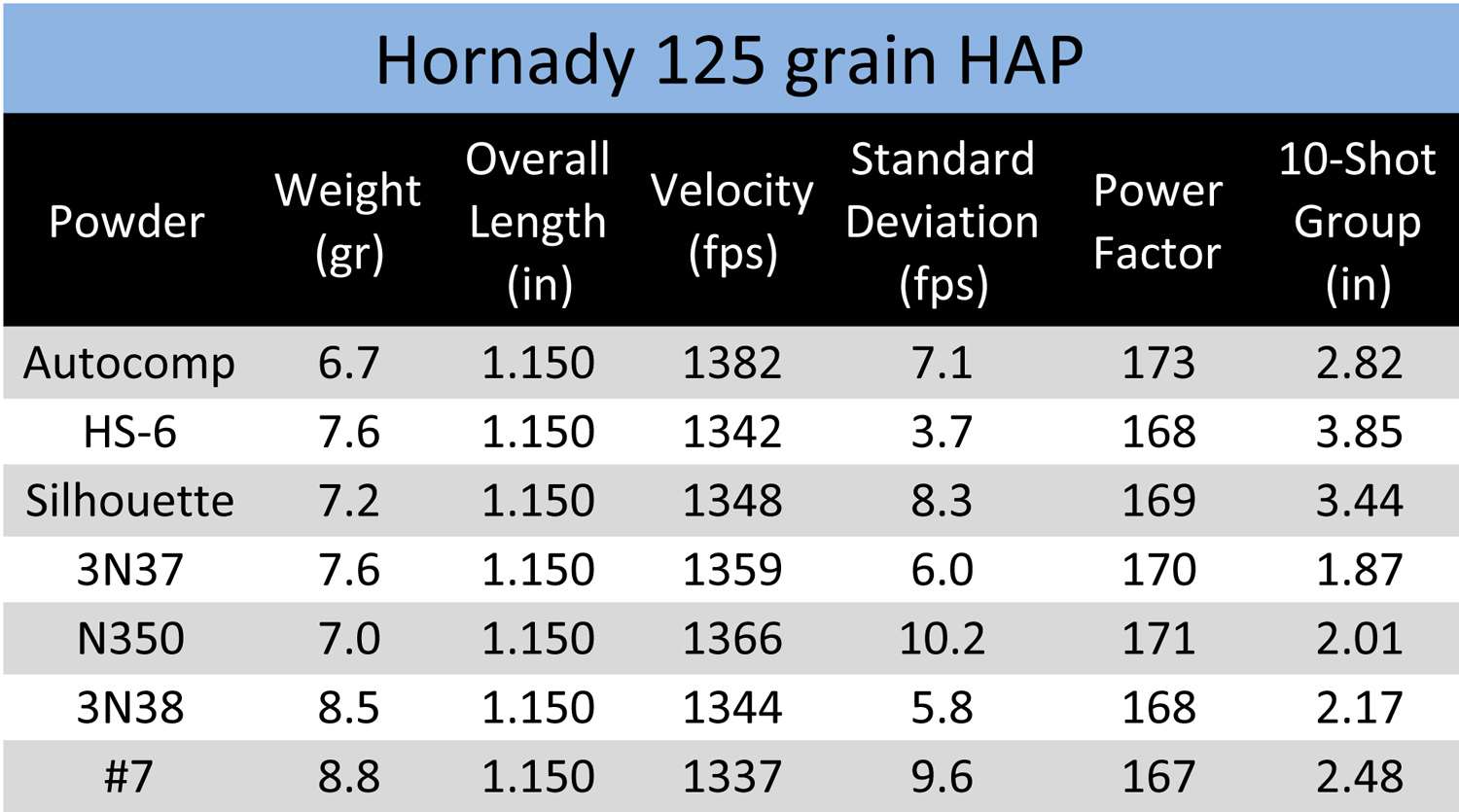
In general, a longer barrel should provide more speed and you can use less powder, whereas a shorter barrel should require more powder. No two barrels are alike, and some barrels are “slow” or “fast” regardless of their length, and might require more or less powder as needed.
If you have to use a shorter overall length of your ammunition to fit in your chamber, this will raise pressure, so you’ll have to reduce the powder charge to compensate. Pressure increases very quickly when shortening rounds at these high pressures, so proceed with caution.
Most competitors will load their ammunition to produce a power factor that is a few points higher than the minimum. For example, with a power factor of 165, most loaders shoot for a power factor from 168 to 172 to ensure that the ammunition will make power factor when chronographed at a match. Failure to achieve the minimum power factor means that the shooter will be scored Minor power factor, which receives less points for hits in the B, C and D zones. The loads shown were not developed to make a specific power factor, just to exceed 165. If the target power factor was, for example, 170, a slight increase of 0.1 or 0.2 grains would do that for loads that were under 170.
Some shooters follow the general rule of thumb that the slowest speed a load produces should be no lower than the minimum power factor. Since different powders will produce varying extreme spreads in velocity, a powder with a wide extreme spread might warrant a higher “target” power factor than another powder. Handloaders should look closely at their velocity data with this in mind. Some powders are temperature sensitive and one might have to take this into consideration was well.
There is no single gunpowder that works “best” for all shooters, because we’re not alike, nor are all guns. Most shooters experiment with different powders to determine what works best for them.
Accuracy was average with these loads, ranging from just under two inches to just over four inches. 3N37 produced the best groups with both bullets. This pistol is not particularly accurate, and these loads were typical of what it produces at 25 yards with any ammo or barrel. I plan to test these powders in a more accurate pistol to see if any of them stand out.
These loads are only intended for competitors using special guns and barrels designed for shooting 9 Major. Check with your gunsmith to make sure your gun meets the necessary criteria. Use of 9 Major loads in guns not specifically designed for Open Division competition can result in a very dangerous condition that can lead to damage to the firearm and injury or death to the shooter and bystanders.
Disclaimer
The author is not responsible for mishaps of any kind, which might occur from the use of this data in developing your handloads. It is the user’s responsibility to follow safe handloading guidelines to develop safe ammunition. You use this data at your own risk. No responsibility for the use or safety in use of this data is assumed or implied.
References
1Miller, B. (2014) Compensators: pressure or gas? Shooting Times, April 9, 2014.
2Miller, B. (2015) Gunpowder and Recoil. Edited by Jerry Lee. Gun Digest 2015, 69th Annual Edition, 238-241.













